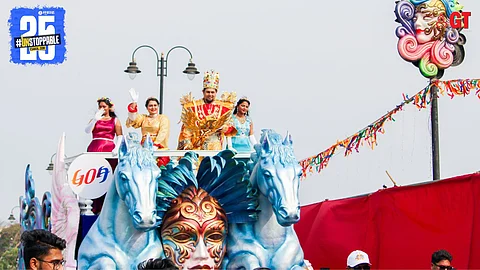

Three of Carnival’s four days are over, and it is time to ponder on what could have made it better. This festival did not originate in Goa, but is one of the many that was assimilated by the locals and that is one reason why it still has a strong, indigenous touch.
Carnival, or Carnaval, is about having fun – clean fun and it is best understood when the concept of, if you point one finger at another, four point back at you. The four-day festival was of, and for, the community; and they were days when all got together and in unison made the others laugh.
There was merriment because these were four days when everyone shared – eating, drinking, singing, dancing and even sleeping where possible. Slowly things began to change.
Carnival is a major event in Brazil, which cannot and will not be replicated in any other part of the world because the ethos of Brazil lives with the Brazilians. We will always be the imitators, and so will those who try to follow.
There was merriment because these were four days when everyone shared – eating, drinking, singing, dancing and even sleeping where possible. Slowly things began to change.
Fifty years ago, Carnaval in a village called Varca in South Goa was about running around with containers of water to splash on passersby and powder colours to paint them.
During the day, small and large groups, would come by, splash water and colour, sing songs, perform skits, and after sharing a few swigs of the choicest local brew would walk to the next house. It was laughter all the way.
Those were four days of the year when one had to run to the washroom to cleanse oneself off the colours, and then wait to be coloured all over again. It was fun!
At the end of the day, the hair would be coloured, the clothes would be soiled, and at times, the colour seeped into school bags, smearing the books inside. No one got shouted at, because the spirit of Carnaval was high.
It didn’t matter what one’s religion or caste was. What mattered was that everyone who joined did so keeping in focus the spirit of good times, and there was no one who wanted to be left out.
The four-day festival was of, and for, the community; and they were days when all got together and in unison made the others laugh.
In those days, nobody had heard of King Momo or the concept of floats or parades. King Momo became a reality after pictures and stories of Brazil’s four-day extravaganza circulated in Goa.
With King Momo flowed in money, which means commercialism, and with each passing year, the element of fun began to diminish. If we want to organise Carnival, today, it is because we do not want to miss out on the money associated with the festival.
Even after the start of floats, with King Momo leading, the element of merriment remained. Fun, for many back then, was being part of the parade; and for others, cheering those swinging by. Whether in rhythm or not, bodies swayed.
Carnaval is now a festival to attract tourists; not for the locals to participate because the gist of fun has been lost, or is on its way of getting lost, for the essence of fun has been diluted.
Carnaval is now a festival to attract tourists; not for the locals to participate because the gist of fun has been lost, or is on its way of getting lost, for the essence of fun has been diluted.
The festival will stutter, and even end up in a wobble, if the element of good times is not retained by the locals. For that, the focus should be on the hinterland because that is where the festival took its shape in the beginning.
Don’t take to the city what has been designed by the villagers just because rural places appear urban in nature. Carnaval is not about looks, but about feelings!